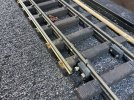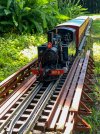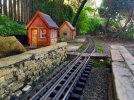curtis
Registered
I have a couple of meters of track that run parallel to the edge of the pond as well as a few bridges. I wanted to add a guard rail to minimise the risk of derailments escalating. I knew a few people on this forum have added guardrails to off-the-shelf track (LGB, TrainLine 45) and I'm curious how you went about it.
Appreciate the advice in advance!
Curtis
Appreciate the advice in advance!
Curtis




